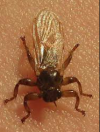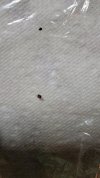35-acre
5 year old buck +
At my NY hunting camp hoping for a great hunt this morning. It would be the first sunny day in weeks.
I took a shower last night and thinking back now, I probably had a tick on me then. But at 12:30 this morning I was restless and my hand brushed along my ribs under my arm and I felt a "sliver" - oh crap!
Jumped out of bed, grabbed my flashlight and sure enough - a tick! I have a kit for removal that has tweezers and a magnifier attached. But given the location, I had to look in a mirror with the flashlight pointed at my side, while trying to move my chest out of the way and line up the magnifier and tweezers. Needless to say, I got it out in 2 pieces and one of the mouth probes is still in. I got most of the head out and the body.
Here I sit in the doctor's office instead of the hillside stand I was going to be in. This sucks! I'm hoping they get the other piece out and give me some meds and send me on my way.
Stay safe out there. Check yourself and keep your gear sprayed down. Scent control isn't worth the time out of the field...
I took a shower last night and thinking back now, I probably had a tick on me then. But at 12:30 this morning I was restless and my hand brushed along my ribs under my arm and I felt a "sliver" - oh crap!
Jumped out of bed, grabbed my flashlight and sure enough - a tick! I have a kit for removal that has tweezers and a magnifier attached. But given the location, I had to look in a mirror with the flashlight pointed at my side, while trying to move my chest out of the way and line up the magnifier and tweezers. Needless to say, I got it out in 2 pieces and one of the mouth probes is still in. I got most of the head out and the body.
Here I sit in the doctor's office instead of the hillside stand I was going to be in. This sucks! I'm hoping they get the other piece out and give me some meds and send me on my way.
Stay safe out there. Check yourself and keep your gear sprayed down. Scent control isn't worth the time out of the field...


